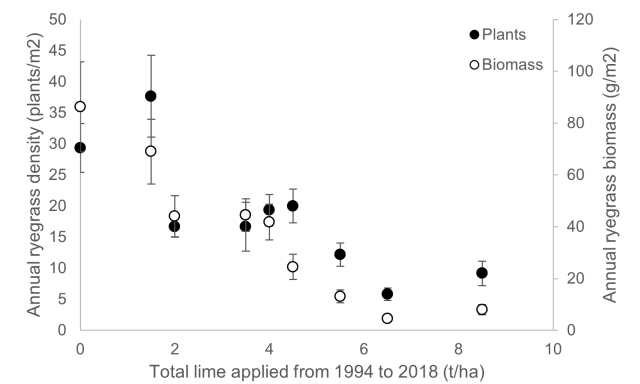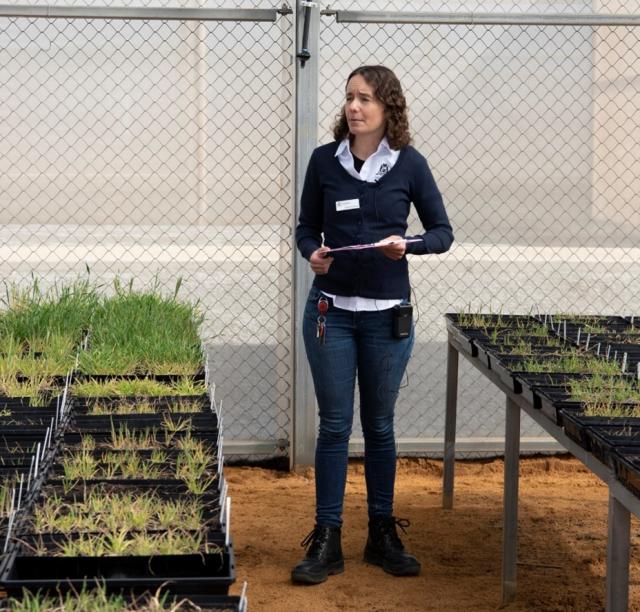This issue of Protecting WA Crops will investigate the impact of liming on weed growth, rhizoctonia root rot activity and crop susceptibility to Root Lesion Nematodes (RLN).
On a national scale, annual crop yield loss due to competition from surviving in-crop weeds is estimated to cost Australian growers $278 million. Competition from a healthy crop remains one of the most cost-effective methods of weed control. For areas with acidic soils, improved crop competition could be achieved by applying lime.
The DPIRD soils team investigated the relationship between liming and weed control over multiple seasons and the key finding was that liming could improve a crop’s ability to compete against weeds. Trial plots that were limed in 1991 and 2000, and subsequently had increased soil pH, increased barley yield and reduced annual ryegrass biomass in 2009.
When soil acidity is regulated following the application of lime, the growing environment is improved and the plants are healthier, grow more efficiently and better resist the effect of weeds, pests and disease.
This newsletter issue follows on from Protecting WA Crops Issue 20 Impacts of mechanical soil amelioration on weeds, soilborne nematode pests and fungal pathogens.
Liming reduces weed growth
The effect that application of lime and incorporation of lime would have on the growth and seed set of annual ryegrass within a crop was investigated by a team of DPIRD researchers, led by Dr Catherine Borger in 2018. Two field sites were located at Merredin (lime was applied in 1994) and Wongan Hills (limed in 2014).
At a glance
- Historical lime application reduced the density and biomass of annual ryegrass in wheat crops, as measured in the 2018 season.
- Like crops, annual ryegrass does not like acidic conditions and grows best when the soil pH is close to neutral.
- Given that annual ryegrass growth was reduced in these field trials, it is likely that application of lime and the subsequent increase in soil pH improved the growth and competitive ability of wheat.
- Altered soil chemistry from lime application may also have influenced herbicide performance, although other work within DPIRD has not found an interaction between liming and efficacy of various herbicides.
- Improved crop competition has previously been shown to reduce annual ryegrass growth and seed production.
Merredin Research Facility in 2016 on a yellow sand
Field trial treatments included a continuous wheat (2016-2018) or wheat-chemical fallow rotation (i.e. wheat in 2016, chemical fallow in 2017 and wheat in 2018), lime applied at various rates of 0, 2, 4 or 6 t/ha and initial cultivation to incorporate the lime (with offset discs to a depth of 15cm). Annual ryegrass density was assessed on 12 July 2018 and annual ryegrass biomass was harvested on 10 October 2018.
Annual ryegrass density and biomass were both reduced by increasing rates of lime (Table 1).
| Annual ryegrass | Lime (t/ha) | P | |||
|---|---|---|---|---|---|
| 0 | 2 | 4 | 6 | ||
| Density (plants/m2) | 14.2 | 11.3 | 4.1 | 1.8 | <0.001 |
| Biomass (g/m2) | 26.8 | 30.9 | 10.8 | 11.4 | 0.008 |
The wheat-chemical fallow rotation had lower annual ryegrass density than the continuous wheat rotation (1.0 and 17.9 plants/m2) and lower annual ryegrass biomass (3.6 and 46.2 g/m2). Incorporation of lime in the continuous wheat rotation reduced annual ryegrass density (12.1 plants/m2) compared to the non-incorporated treatments (25.1 plants/m2).
In the wheat-fallow rotation there was no effect of incorporation, due to very low weed density (1.5 and 0.6 plants/m2) in the incorporated or non-incorporated treatments in the fallow treatments.
Wongan Hills established in 1994 on a yellow sand
Lime was applied at various rates in 1994, further lime applied to half of the plots in 1998 and final lime applications made in 2014.
The trial was sown to wheat in 2018. Initial annual ryegrass density was low (0 to 5 plants/m2) due to a dry autumn, but cohorts emerged later in the season. On 19 October 2018, annual ryegrass density was recorded, before harvesting annual ryegrass biomass.

Read the full Grains Research Updates paper describing this work.

